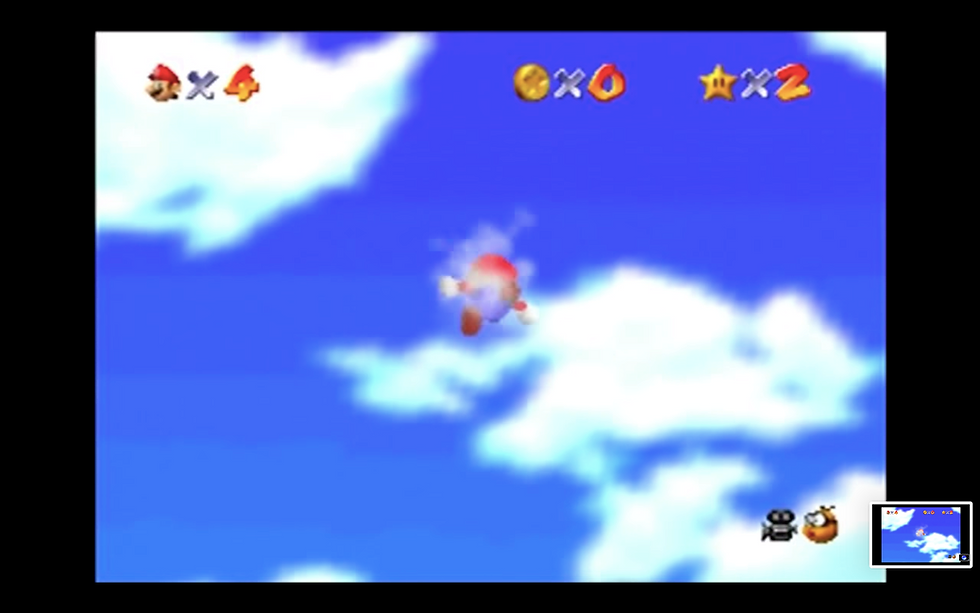Game Review: Super Mario 64
- xuy1

- Oct 20, 2019
- 4 min read
Super Mario 64 is released in 1996 with the Nintendo 64 console. The game begins with Princess' Peach inviting Mario to her castle for a slice of cake, but of course when our protagonist arrives there is no one home. Mario jumps into paintings to beat the bosses in different rooms, each multiple times, to eventually face down Bowser, the ultimate boss for the third time and rescues the princess.
Launched at the dawn of the virtual era, and at the dawn of the 21st century, Super Mario 64 blazes the trail in many ways. It is the first to have user adjusted camera angels, the first open-world Mario game; it is also the game in which Mario learns to climb a tree. To me, this simple mechanic epitomizes how this game, in my friend's words, "simply makes me so happy".
The Climb
Before you even enter the castle, there is a sign that tells you: hold A button to jump onto a tree, climb up, and then press B to do a handstand.
The average player, I assume, cannot climb a tree in 3 seconds with perfectly synchronized hand-leg movements exhibited by Mario, nor jump perfectly onto a tree upon first attempt. The coarse bark bark scratching against the palm, the deliberation before each move, the sliding down and fighting back up, are all reduced to pushing a button. The Mario climb is way more successful than I could ever do in real life--unless I spend a lot of time practicing it. By inhabiting Mario's body temporally, I'm enjoying the thrill and satisfaction that comes from a super-fit, well trained body, without going through the frustration and long time of training. Watching Mario climb a tree is satisfying not only because he does it so well, but because I have tried to move my clumsy body. Hence watching Mario climb tree, doing wall jumps, and swim cozily expands the sensorial limits of my own body.
Handstand
At the top of the tree, you can chose to do a handstand. Unlike climbing a tree in super smooth fashion, that is a movement I think no one can really achieve--i.e. physically impossible. However, as we discussed in class (?), it feels real because there are more "realistic" movements leading up to it. For example, in the jumping tutorials, wall jumps come before triple jumps. Wall jumps, like professional tree-climbing, are achievable. In an already expanded bodily experience, things a little bit beyond physiological possibility would not seem stretched, but provided the most "realistic" sensations. Moreover, unlike a 2D jump or squashing mushrooms, tree-climbing and wall-jumps are things real people attempt in real life. Going from the real (walking) to the plausible (climb) and then to the improbable (flying, with a hat or on an owl), SM64 guides you to unsuspectingly experience these movements. Here, augmented is not merely the perceived/experience corporeal capability, but also expected bodily potential.

Virtuality
The mid 1980s marks a shift to center virtuality in cybernetics. As Katherine Hayles defines it: "Virtuality is the cultural perception that material objects are interpenetrated by information patterns" (How We Became Posthuman). In the context of a game, this means the player's "identification" with the avatar. The usual example is a VR game where the movement of the player's physical body is mirrored in the simulation, and the information patter is housed in the moving arm of player.
Super Mario 64 is not a virtual reality game in the commonsense of the word, but it is extremely immersive and has inspired game makers after it. Instead of creating a virtual world, the game leads the player to "identify" with the Avatar to be bodily immersed. The core of virtuality, as Mario shows, is not for the digital to become more biological, but for the biological to be penetrated, immersed in the information pattern of the digital.
Glitches/Embodiment
Katherine Hayles reminds us that we are still embodied beings, just as at the very beginning of the game, the Lakitu Bros reminds us we are in fact looking a 2D screen, i.e. from an angle at a 3D world. The control of the camera angle acts as a reminder that we are in fact not Mario. Unlike first person games where the movement of the camera is continuous with the movement of the mouse, the N64 camera adjustment is done with discrete clicks. This breaks us from the continuous visual movement we have in real life.
There are times when the games feels off: for example, you press B button to hit someone as well as to talk and communicate. It feels odd that the same physical action (pressing B button) can generate different information, depending on the design of the game. This is still present in the VR games today: same click allows you to hold/throw different items in Superhot. I'm trying to say that we never really "identify" with the avatar, or the digital manifestation; in fact, we are always aware of the fact that we're not the player. This does not make the game any less immersive.
Identification itself situates the digital and the material as separate; this is exactly Hayles' critique of the conventional definition of virtuality. To dissolve the dichotomy, one first needs to first cease to see one's body as a delimited entity. What "I" am at the moment of gameplay is not just the player, the biological, or the informational experience suspended in the disembodied cyberspace. Rather, the experience includes both my fingers pushing against the button, and Mario gliding down a mountain of snow. I think Super Mario 64 shows us, and did best at, is demonstrating immersion is not the identification of one thing and another, but the muffling of personal boundaries at the moment of gameplay.
Bibliography
N. Katherine Hayles. How We Became Posthuman: Virtual Bodies in Cybernetics, Literature, and Informatics. (Chicago, IL: University of Chicago Press, 1999.)




Comments